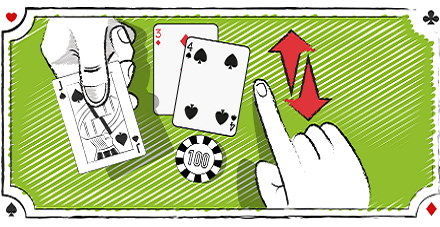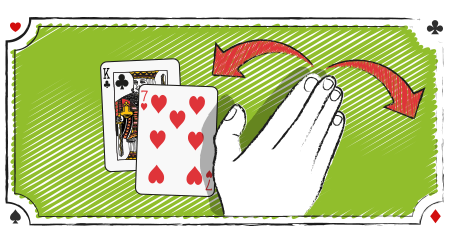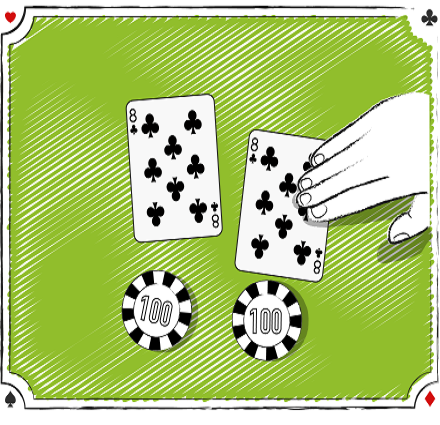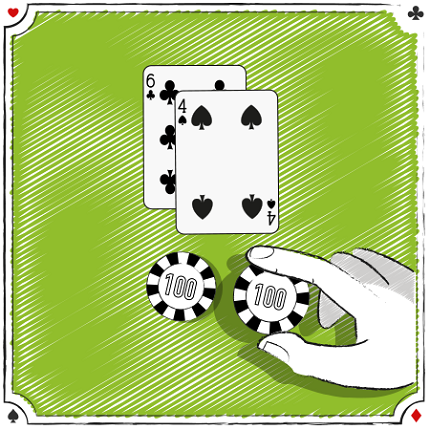The Basic Rules
- Blackjack starts with players making bets.
- The dealer deals 2 cards to the players and two to himself but you can only see his first card (1 card face up, the other face down).
- Blackjack card values: All cards count their face value in blackjack. Picture cards count as 10 and the ace can count as either 1 or 11. Card suits have no meaning in blackjack. The total of any hand is the sum of the card values in the hand.
- Players must decide whether to stand (receive no more cards), hit (receive one extra card), surrender (forfeit your hand and retrieve half your original wager back), double down (receive an extra card and double your original wager in the process), or split (if you have two cards of the same value).
- The dealer acts last and must hit on 16 or less and stand on 17 through 21.
- Players win when their hand totals higher than the dealer’s hand, or they have 21 or less when the dealer busts (i.e., exceeds 21).
Therefore, the objective of blackjack is: to beat the dealer’s hand by either:
2) by not going over 21 when the dealer does.
Card Values
As mentioned previously, all cards count their face value in blackjack. Picture cards count as 10 and the ace can count as either 1 or 11. Card suits have no meaning in blackjack. The total of any hand is the sum of the card values in the hand. A hand containing a 4-5-8 totals 17. Another containing a queen-5 totals 15. It is always assumed that the ace counts as 11 unless so doing would make your hand total exceed 21, in which case the ace reverts to a value of 1.
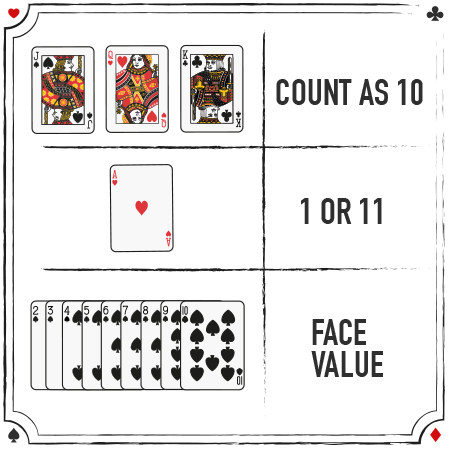
Busting
When a player or dealer’s hand exceeds a total of 21, this is known as busting. (Sometimes the term “break” is used when the dealer’s hand exceeds 21.) So if a player was dealt a 10-6, drew one more card which was a 9, the player busted (i.e., because his hand had a total of 25).
Hard vs Soft Hands
A hard hand is any hand that either does not contain an ace or if it does, counts the ace as 1. For example, 10-8 is a hard 18; 5-A-10-2 is a hard 18.
Any hand that contains an ace that counts as 11 is known as a soft hand. For example, A-5 is a soft 16; A-2-5 is a soft 18, and 3-2-A-3 is a soft 19.
When you receive your first two cards and one of them is an ace, count the ace as 11. Often when you are dealt a soft hand and draw more cards your hand will convert to a hard hand. For example, suppose a player is dealt a 5-A which is a soft 16, and he draws another card. Suppose the draw card was a 6. The player now has a hard 12 (i.e., you can never bust when you draw to a soft hand). The reason you need to know the difference between a hard and soft hand in blackjack is because the playing strategy is often different even though the total of the hand is the same. For example, a 10-6 (hard 16) is played differently than an A-5 (soft 16).
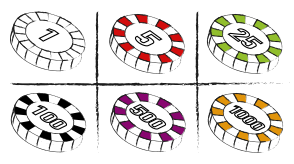
Chip Value
In most casinos, chips are colour coded to signify their denomination although usually the value is imprinted on the chip, as well. For example, a white chip usually signifies €1 denomination, red is €5, green is €25, black is €100, purple is €500, and orange is €1,000.
Number of Decks of Cards
Every table should have signage that specifies what the minimum and maximum betting limits are. For example, if a table has a minimum bet of €25 you are not allowed to bet a red (€5) chip; your minimum bet must be €25. So before you sit down to play, be sure to check the betting limits posted on the table.
Prior to the deal of the cards, all players must make a bet by placing chips in their respective betting boxes. Every player and the dealer will receive two cards. One of the dealer’s cards (known as the dealer’s upcard) is always dealt face up so that players can see its value. The other dealer’s card, known as the dealer’s downcard or hole card, is unseen. The two player cards can be dealt either face up or face down.
In general, in games that are dealt from a dealing shoe (normally containing 4, 6 or 8 decks of cards) the players’ cards are dealt face up. In this case, you should not handle the cards.
In games in which the dealer deals from the hand by pitching the cards to the players (single- or double-deck games), the player cards are usually dealt both face down. In these games, it is permissible for the player to handle the cards with one hand only, and the cards must always be above the table.
After the player looks at his initial two cards and sees the value of one of the dealer’s two cards, the player must make a playing decision.
This includes the following playing options:
HITTING RULES
This means you want the dealer to give another card to your hand. In shoe games, indicate to the dealer that you want a hit by making a beckoning motion with your finger or tapping the table behind your cards with your finger. In hand-held games, scratch the edges of the cards in your hand lightly on the felt.
STANDING RULES
This means you are satisfied with the total of the hand and want to stand with the cards you have. In shoe games, indicate that you want to stand by waving your hand over the cards, palm down. In hand-held games, tuck your cards under the chips that you have in the betting box.
PAIR SPLITTING RULES
If you have two like cards (e.g., a pair of 6s or aces), you could exercise the option to split them. When you split, you must make another bet equal to your original bet, just place your chip next to the original chip bet on the hand. When you pair split, you are playing each card as a separate hand and you can draw as many cards as you like to each hand, except split aces; most casinos will allow only one draw card to each ace. For example, if you were dealt a pair of 8s, and split, you would have two separate hands with a count of 8 in each hand. You are required to play out one of the split hands (on your right) first to completion before the other.
In shoe games, you indicate that you want to split by placing another chip next to the original chip. For hand-held games, toss the two cards you want to split face up on the layout and then make the secondary wager. Most casinos will also allow players to split any 10-value cards such as a jack-ten or queen-king, although, as you will soon learn about pair splitting, this is not a recommended playing strategy.
DOUBLING DOWN RULES
This playing option allows you to double your initial bet in return for receiving one (and only one) drawcard. In most casinos, you can only double down after you receive your first two cards and before drawing another card. To signal the dealer that you want to double down in shoe-dealt games, just place your chip next to the original chip bet on the hand. In hand-held games, toss your cards on the table face-up and then make the secondary bet.
SURRENDER RULES
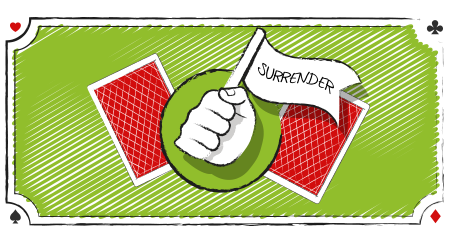
This playing option is sometimes permitted. It allows a player to forfeit the hand immediately with an automatic loss of half the original bet. In most venues, players can surrender their initial two-card hand only after the dealer has checked his cards and ascertained that he doesn’t have a blackjack (known as late surrender). Once a player draws a card, the surrender option is no longer available. If the dealer has a blackjack hand, then surrender is not available.
If you want to surrender your hand, just say to the dealer “surrender.” In some casinos, a hand signal must be given for surrender which is to draw an imaginary line across the felt layout from left to right with your finger. When a player surrenders his hand, the dealer will remove the player’s card from the table and place one half of the player’s bet in the chip rack. The player is no longer involved in that round.
Another type of surrender is sometimes offered and it is known as early surrender. Here players can surrender their hand before the dealer checks her hole card for a blackjack. Early surrender is a more favourable player option than late surrender.
Insurance
When the dealer’s upcard is an ace, she will ask players if they want to make the insurance wager, which is a side bet in which players are betting that the dealer’s hole card will be a ten-value card. Players can make an insurance bet less than or equal to one-half of the initial bet made on the hand. To make the insurance bet, simply place your chips on the insurance line, which is located right above the player’s betting spot. You win your insurance bet if the dealer has a ten-value card in the hole. A winning insurance bet pays off at 2 to 1 odds.
Even Money
When the player has a blackjack hand and the dealer has an ace showing, the dealer will ask the player if he wants “even money.” Even money means the dealer will automatically give you a 1 to 1 (or even money) payoff on your bet before she checks her downcard for a potential blackjack. Taking even money yields the same result as making an insurance bet on your blackjack hand.
Dealer’s Playing Rules
Unlike players, the dealer in blackjack has no playing options. Casino rules specify that a dealer must draw if her hand totals less than 17 and stand when the total is 17 to 21. In some casinos, dealers must stand on soft 17 and in others, they must hit. It’s better for the player if the rules specify the dealer must stand on soft 17.
Winning and Losing a Hand
- If you have a 21, you’ll win a 3:2 payout regardless of the dealer’s hand.
- If you have over 21, you’ll bust and automatically lose.
- If you beat the dealer but don’t get a 21, you’ll win a 1:1 payout.
- If you and the dealer have the same points total, you’ll get your wager back.

Advantages and Disadvantages of Online Blackjack

Advantages
- Convenience. You don’t have to get dressed up and travel somewhere to place a bet; you can do it in the comfort of your home any time day or night (i.e., your home is your casino).
- Because of fierce competition for players, online gambling sites offer lucrative sign-up bonuses to new players, usually adding 10% up to 70% to their initial bankroll.
- Most online sites usually have better blackjack rules than brick-and-mortar casinos (although it pays to check the blackjack rules before you start playing).
- Usually, there is 24-hour customer service; although here again, this should be confirmed.
- You don’t have to suffer potential annoyances of other players (smokers, complainers, talkers, etc.).
Disadvantages
- Unlike brick and mortar casinos where you can exchange your chips for cash rather quickly, when you gamble on an Internet website and want your money, it may take several days for you to get it.
- There are specific playing requirements to obtain whatever bonuses the site is offering.
- Some sites’ customer service is often lacking.
- Operating a gambling web site in the U.S. is illegal; therefore, most are located offshore and there is no local “government agency” to assist players in the event of a dispute with a gambling site.
- You won’t have the camaraderie and ambience that are present in land-based casinos.
- Playing online blackjack games for real money can be addictive to some players.


